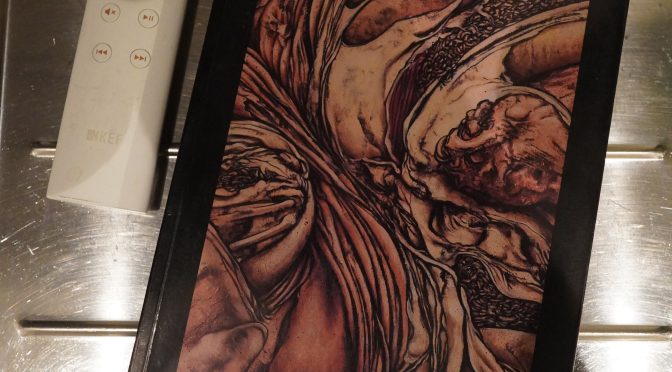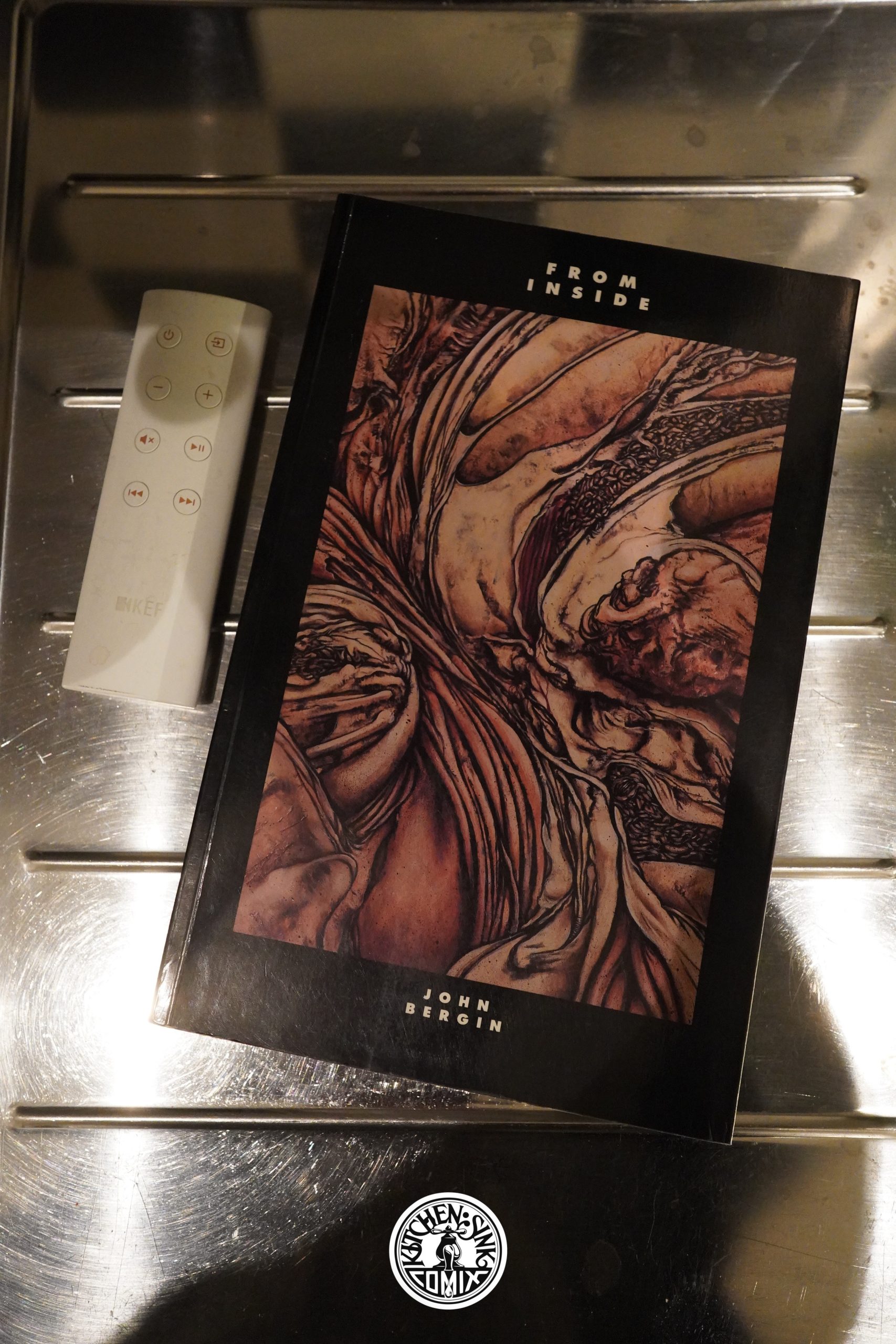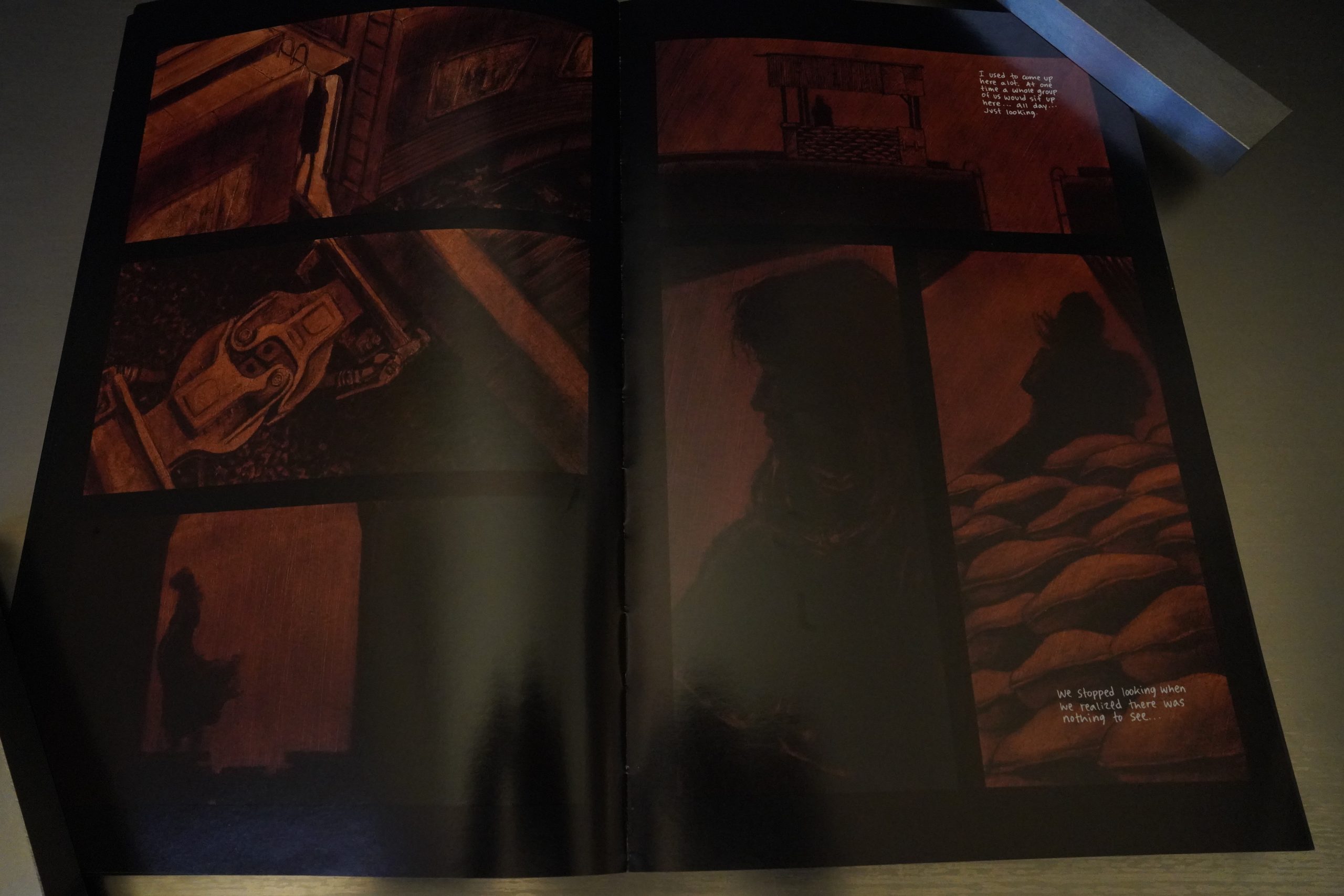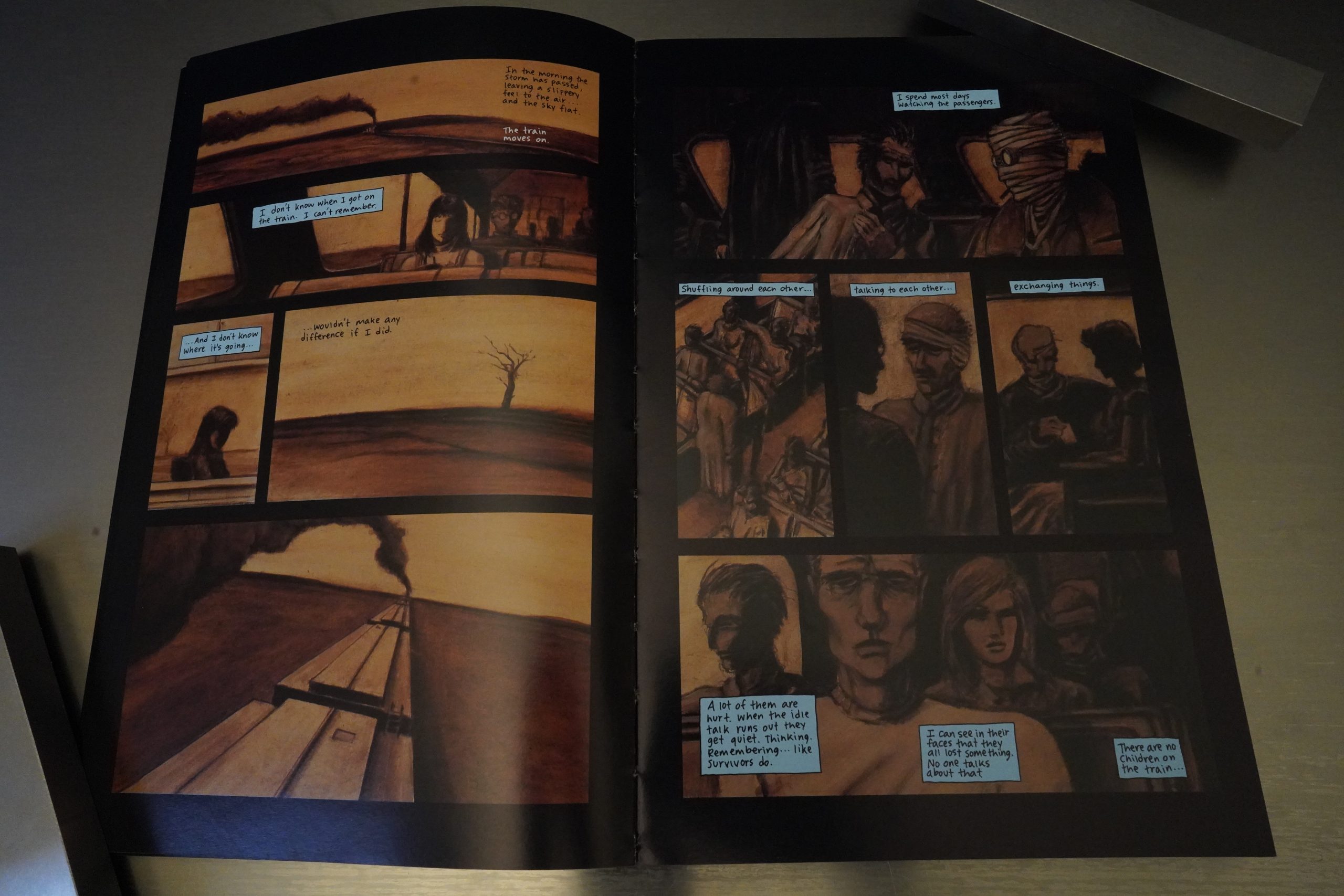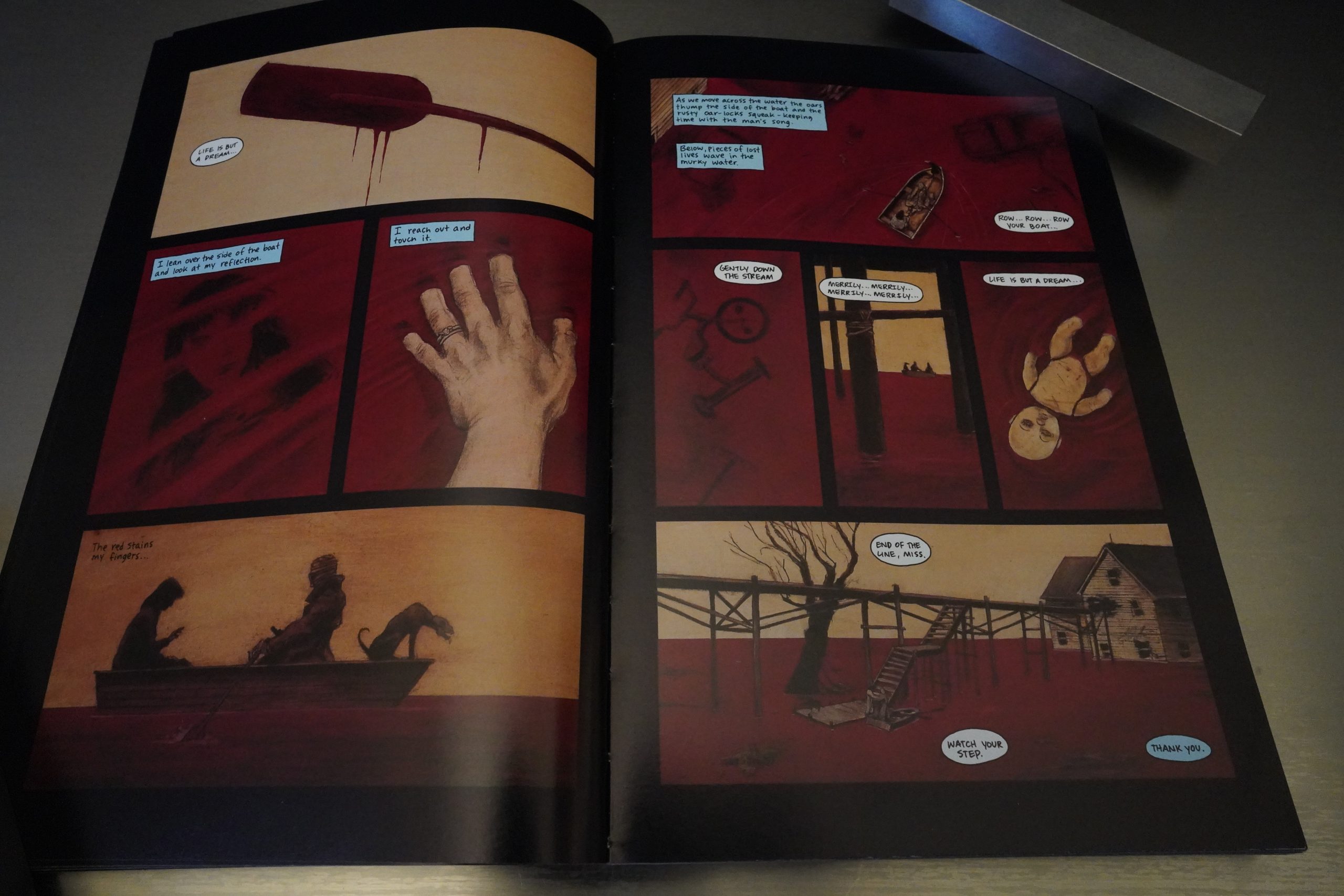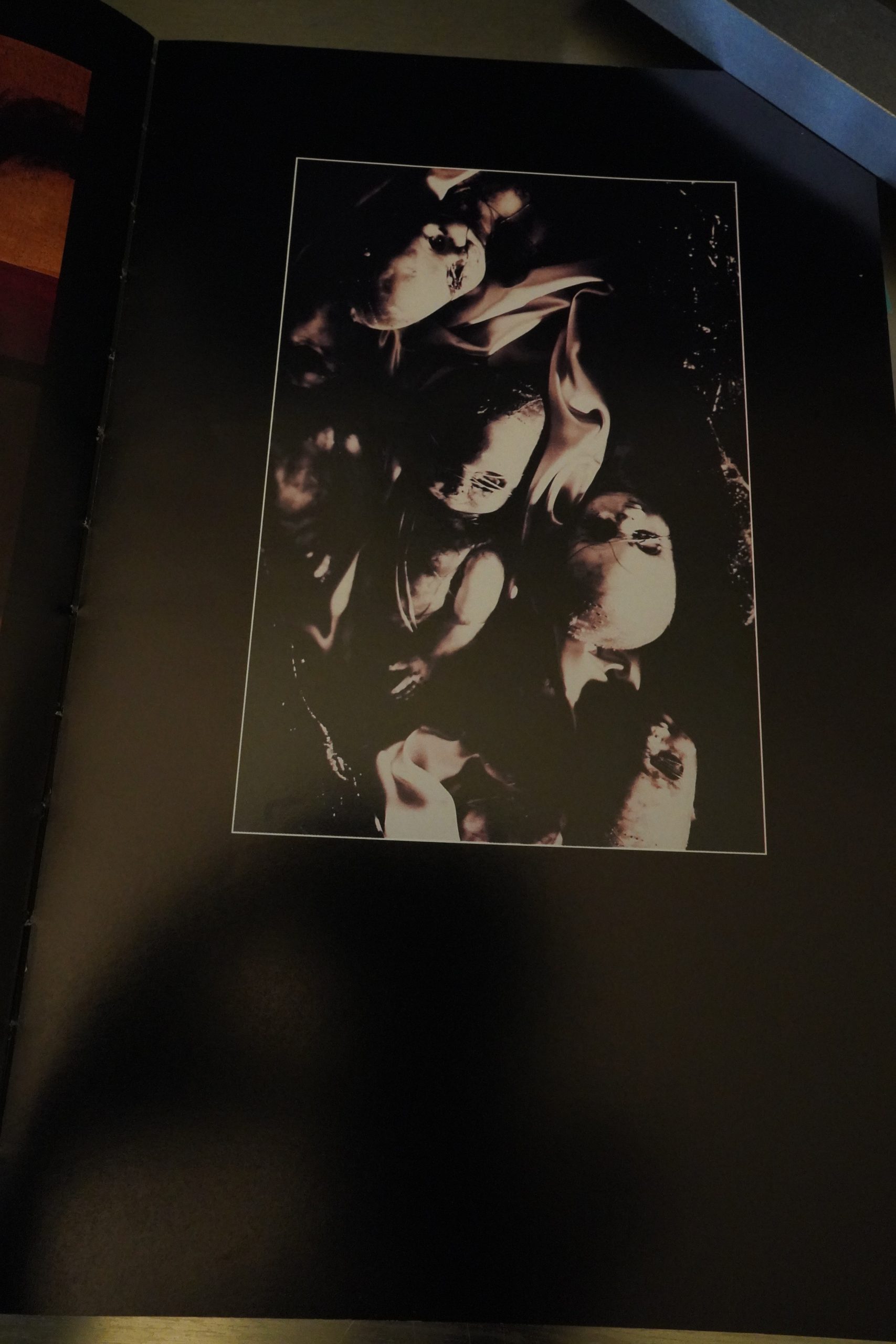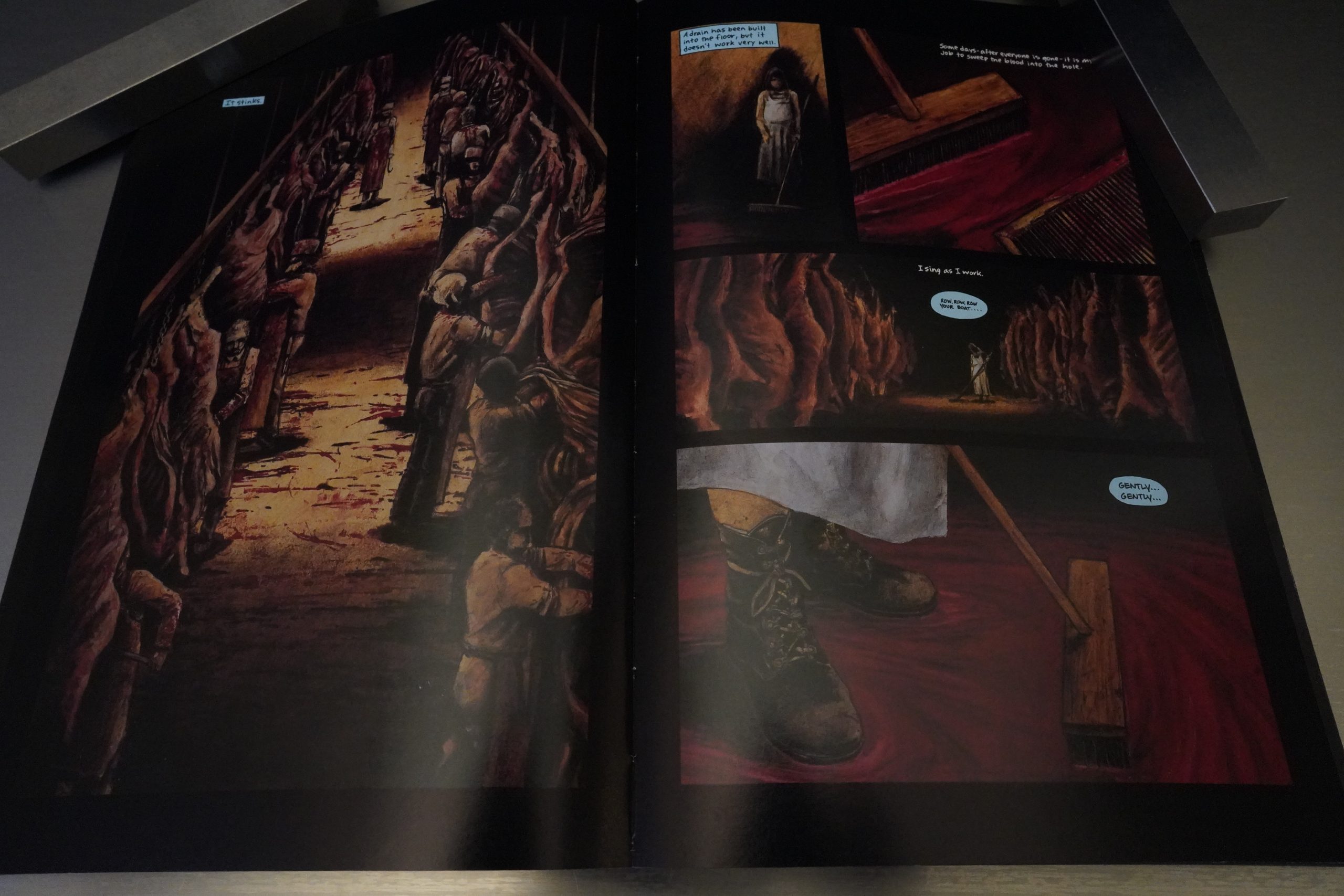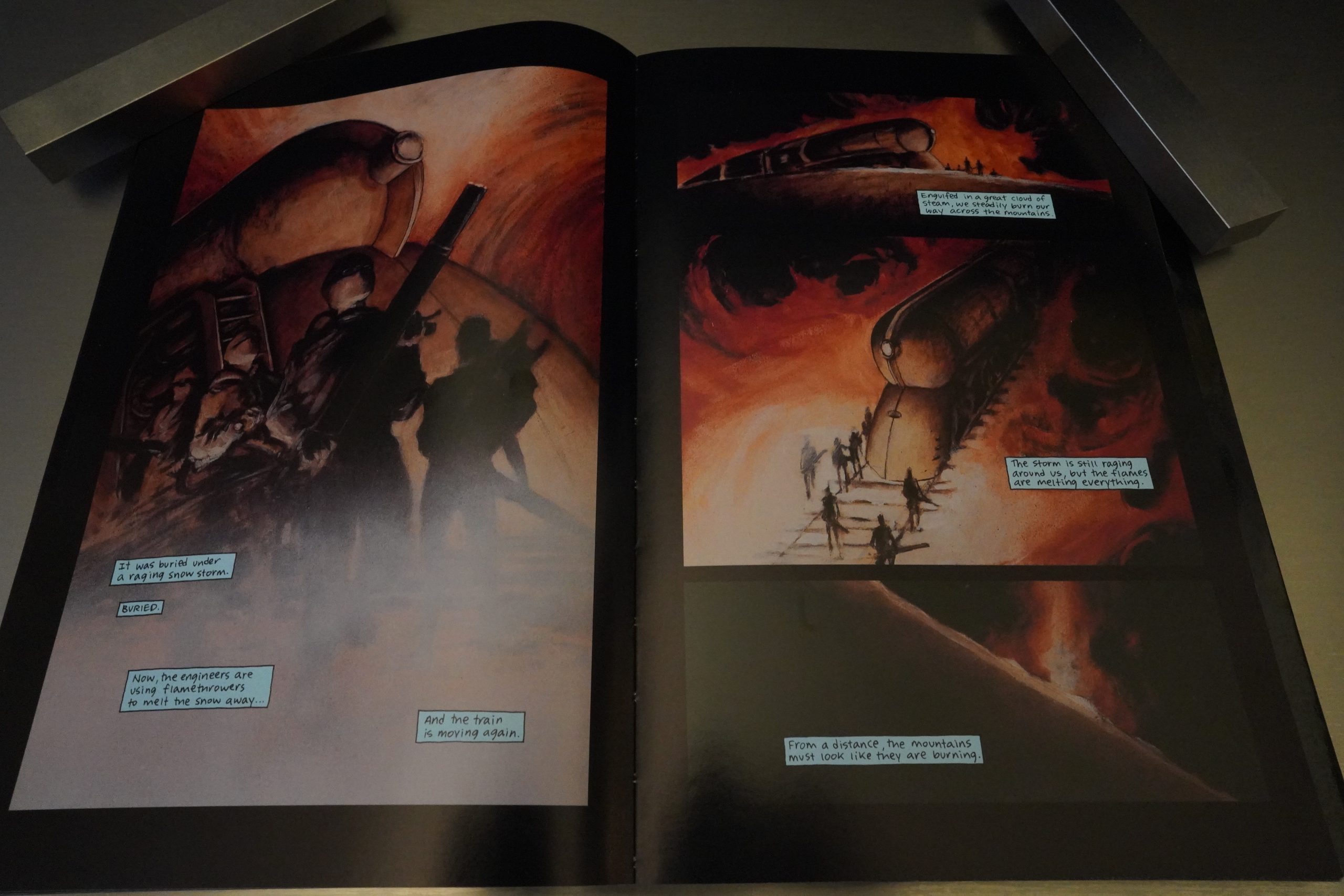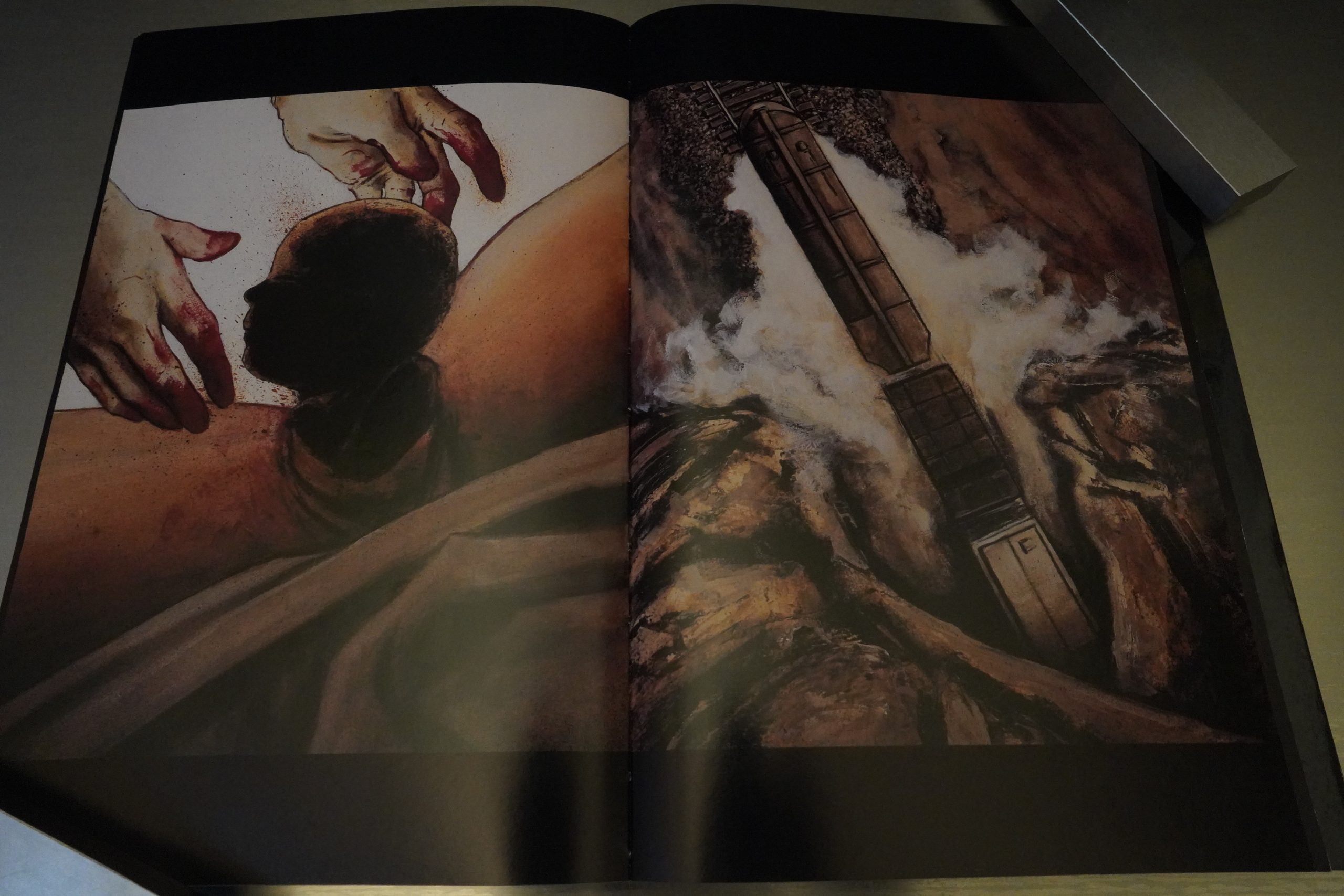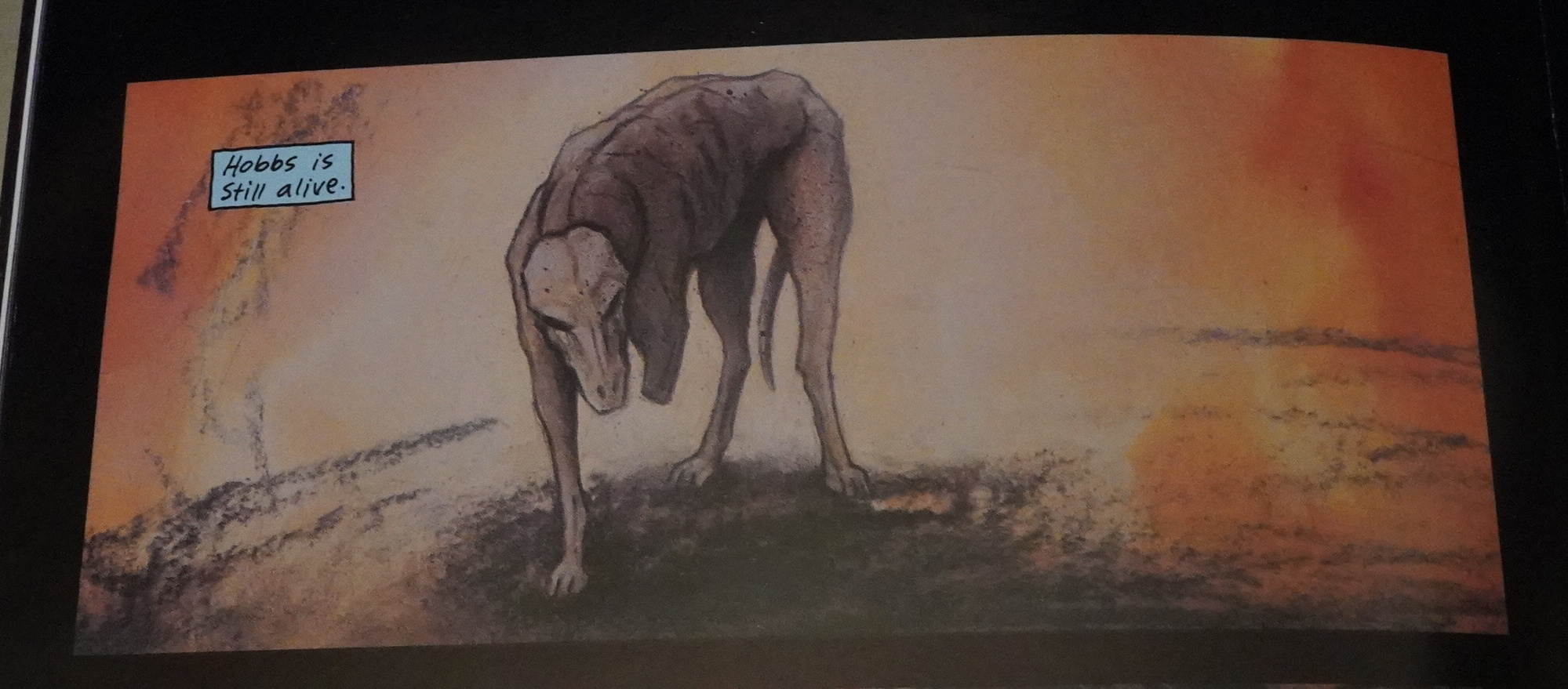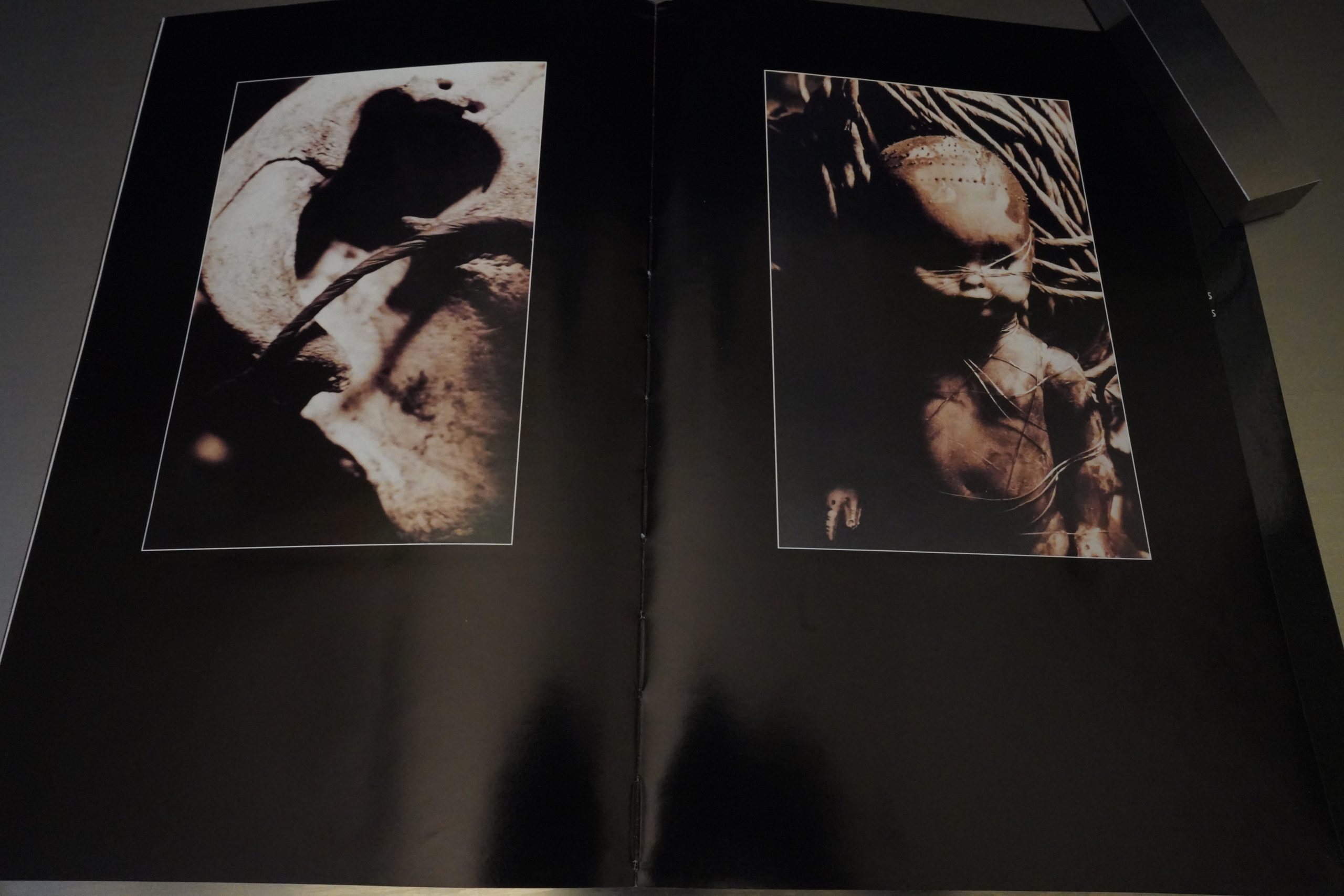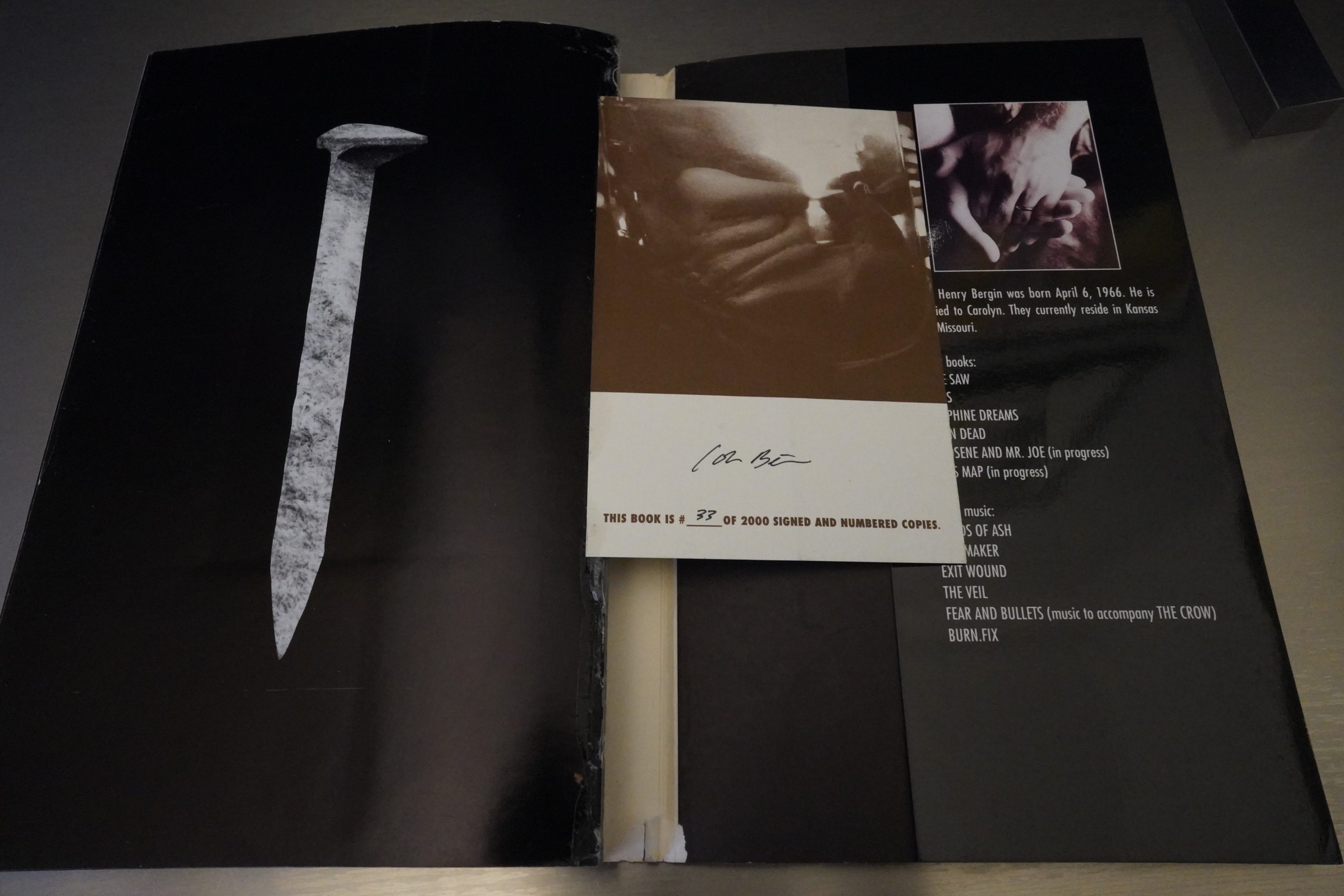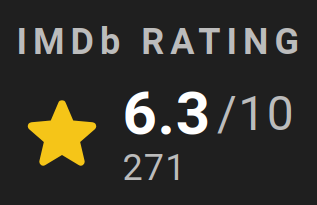From Inside (1993) by John Bergin
This is a thick book — more than 200 pages, I guesstimate? — but more importantly, it’s printed on the most reflective paper stock imaginable, so I’m trying to get some snaps of these pages without everything getting lost in reflective sheen… move that lamp there… turn those lamps off… angle the camera and…
No, still some reflections. Oh well. Anyway, this seems like it’s going to be another take on the post-apocalyptic train-to-nowhere kind of thing, but more symbolic? I wonder whether the Snowpiercer people had read this, because there’s a lot of similarities. But then again, perhaps that just goes with the territory: If you’re doing something featuring a train in a wasteland, there’s certain tropes that comes natural.
This is way more a symbolic journey than a sci fi story, though — you have entire lakes of blood etc.
And… it was kinda by this point my left eyebrow was starting to become arched, because how many clichés is this book going to cover? I mean — mutilated baby dolls? Švankmajer much?
And, yes, it’s not meant to be realistic, but c’mon: The train running into an endless buffalo herd, and then creating an abattoir in some train carts? I guess he thought it would look cool or something? (And yes, there’s cannibalism later, because if course there is.)
It’s also just thoughtless with trivial storytelling points. Everything is told from the point of view of a pregnant women (we’re reading her journal), but the images are constantly depicting things she can’t see, like the mountain being lit up with flames. Do we have an omnipotent third person viewpoint or a tight first person one anyway? Again, what’s depicted seems to be dictated by what the author thought would look cool. Is my guess.
And, yes, there’s a childbirth happening at the same time as the train emerges from the tunnel.
I don’t even know what to say. Is there some book people can consult to ensure that they manage to include all clichés in their works?
Don’t worry — the dog (because of course there’s a dog) survives.
This really is the quintessential Tundra book: I’m guessing Eastman forked over a huge advance to Bergin to do this book? And it’s of dubious artistic merit, with aesthetics seeming to be sourced from pedestrian horror, but “classed up” by being all metaphorical and serious and stuff. That’s what so much of Tundra’s output seemed to be: Wads of cash being dropped on people more comfortable with genre, but then finally being given the chance to be “more creative”, and failing completely.
And apparently they had more doll photos left over, so we get a bunch more after the story ends.
The shocking thing is that they have the audacity to call 2K copies of this a “limited edition”.
Wow — Bergin did a 70 minute animated version of this. Apparently it didn’t get much distribution:
Only 271 votes.
Oh, the full movie is on Youtube.
Robert Sandiford writes in The Comics Journal #183, page 45:
John Bergin’s darkly expressionistic, post-
apocalyptic graphic novel, may as well read
“Welcome to hell”: “I am walking down a
tunnel,” says the narrator. “Flames roar at the
end. The air is sooty and hard to breathe. The
floor vibrates with a distant rumbling,”
probably that of a train. Then she comes
across two men, one fat, the other thin, burning
bodies as if for fuel: men, women, children. It
looks like a scene from the Holocaust. It is a
terrifying, haunting scene; one that echoes
throughout the book and is recapitulated at
the very end.
All this is “just a dream,” she realizes when
she wakes up. But the reality is more than that.
A holocaust has indeed occurred; it is the end Of
the world.[…]
The title of this graphic novel is as much a
metaphor for humanity’s condition as for that
of the woman; whatever the survivors have left
is whatever each holds and brings forth “from
inside”: memories, compassion, a will to live.
And although the woman is watched over by a
mysteriously bandaged guardian angel (who
resembles The Un-
known Soldier or
The Invisible Man)
perhaps the greatest
Of these is the memo-
ries. Despite every-
thing she has already
begun
to
forget, memories
are what abide when
all else is lost, the
woman discovers.
Memories, here —
of the love ofa good
husband or of the
pleasure found in a
chi ldhood toy — are
about trying to re-
main human under
the most inhuman
conditions.[…]
The scenes with the buffaloes highlight one
Of the graphic novel’s particular strengths:
Rarely does a book achieve the fine balance
between words and pictures this one does. Like
his minimalist writing, Bergin’s illustrations
are not unique. There are too many obvious and
unobvious influences at play — Impression-
ism, Eastern European art, Russian cinematog-
raphy, American photography, alternative mu-
ABOVE: From early on in From Inside ‘s story: rhe
sic, the work Ofthe Dutch Masters, and possibly
a little of Chris Van Allsburg, the author Of the
children ‘s Christmas classic, The Polar Express.
Bergin (with some assistance from his wife,
Carolyn) has endeavored to make each painted
page, each panel, a work of art, yet From Inside
is more derivative than distinctive.
Bergin’s script
and artwork, how-
ever, work together
like a well-oiled,
smooth-running
machine. This is
largely due to his
commitment to his
bleak theme, his
care for his melan-
choly protagonist,
and his skilled shap-
ing of a nuclear-
scarred society. Af-
ter the buffaloes
have been cleared,
the woman is as-
signed to one of the
train cars that has
been converted into
a slaughterhouse.
She sings “Row
Your Boat” to pass
the time while she
cleans up one night
Only to pause at the
word “gently” as
she peers up at the
row upon row of
bloody meat hooks.[…]
From Inside is a dark ride. Bergin has
produced a most unusual book in that it is not
relentlessly grim, but ultimately grim. By the
time the woman comes to accept her baby might
be “the miracle of a second chance,” the train
has come to the end of the tracks — at the edge
of a cliff. The birth offers hope, renewed love,
happiness — for all of humanity. But these
can’t last; at least, not in so devastated a world.
The spirit of her dead husband — her guardian
angle — can’t even protect her. The Book of
Revelation has a passage on it, and From Inside
echoes it: On the day of judgment, the living
shall envy the dead.
John Bergin is (or was) friends with The Crow creator James O’Barr, and it shows. Though lacking the adolescent revenge fantasy of O’Barr’s chief work (he has chosen instead a pre-natal, post-apocalyptic nightmare), Bergin’s still feels a bit like a comic adaptation of a very long industrial-music video. And that’s not bad.
This is the one hundred and forty-eighth post in the Entire Kitchen Sink blog series.
